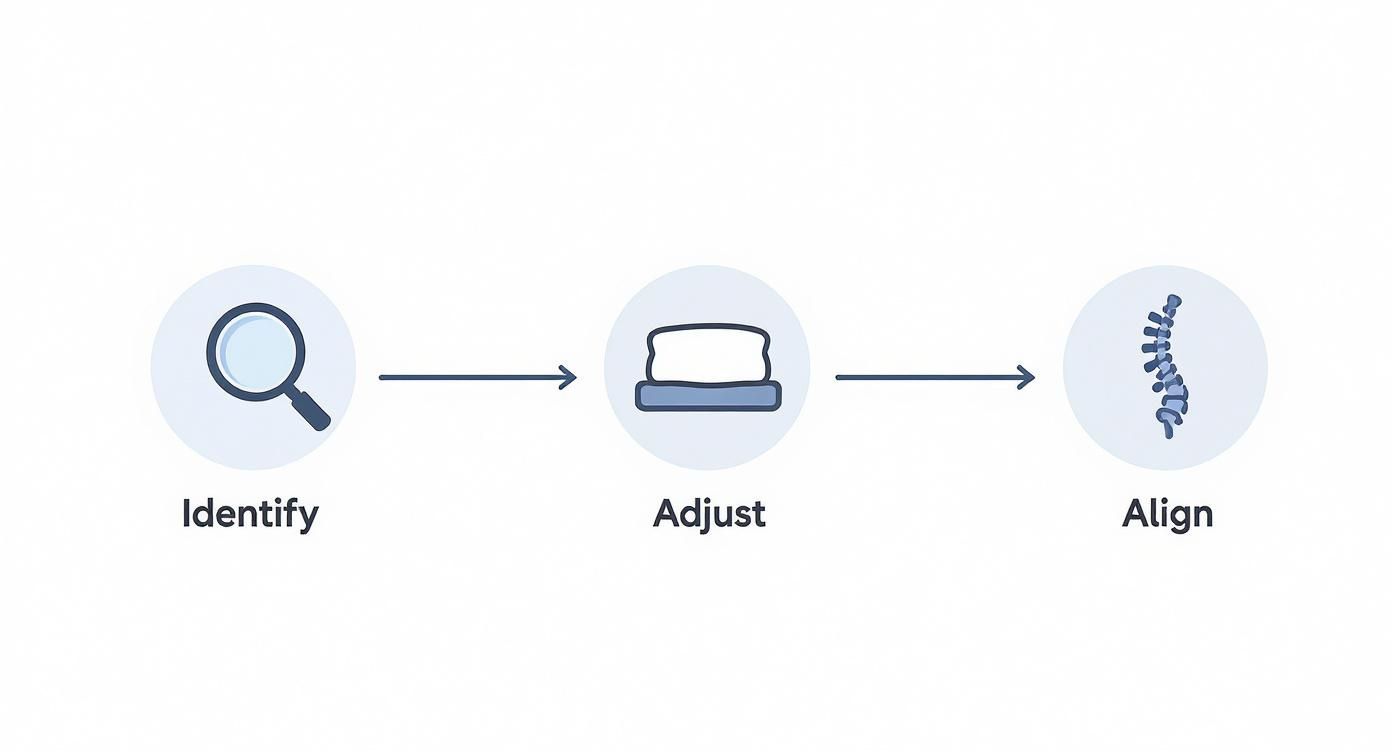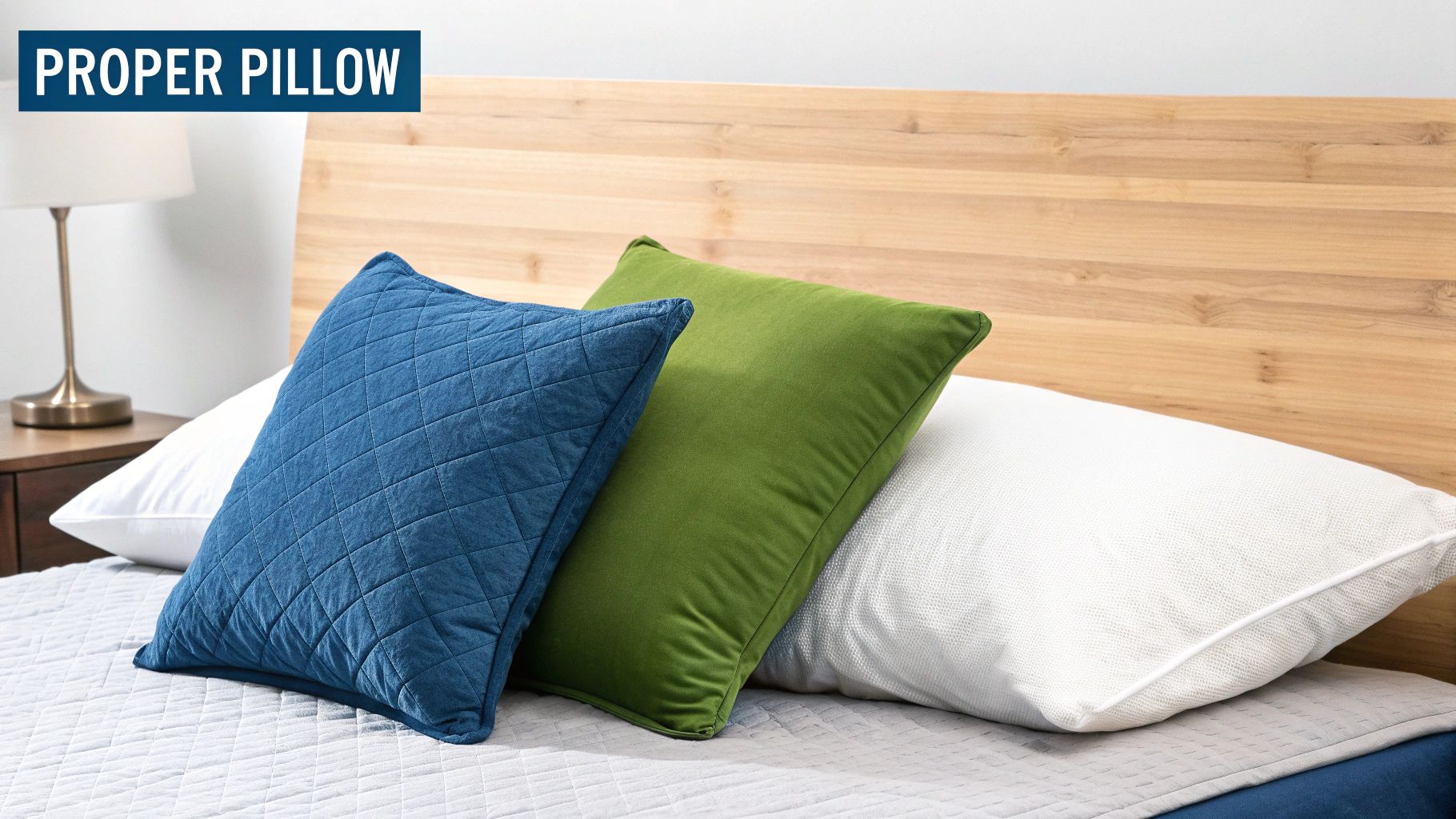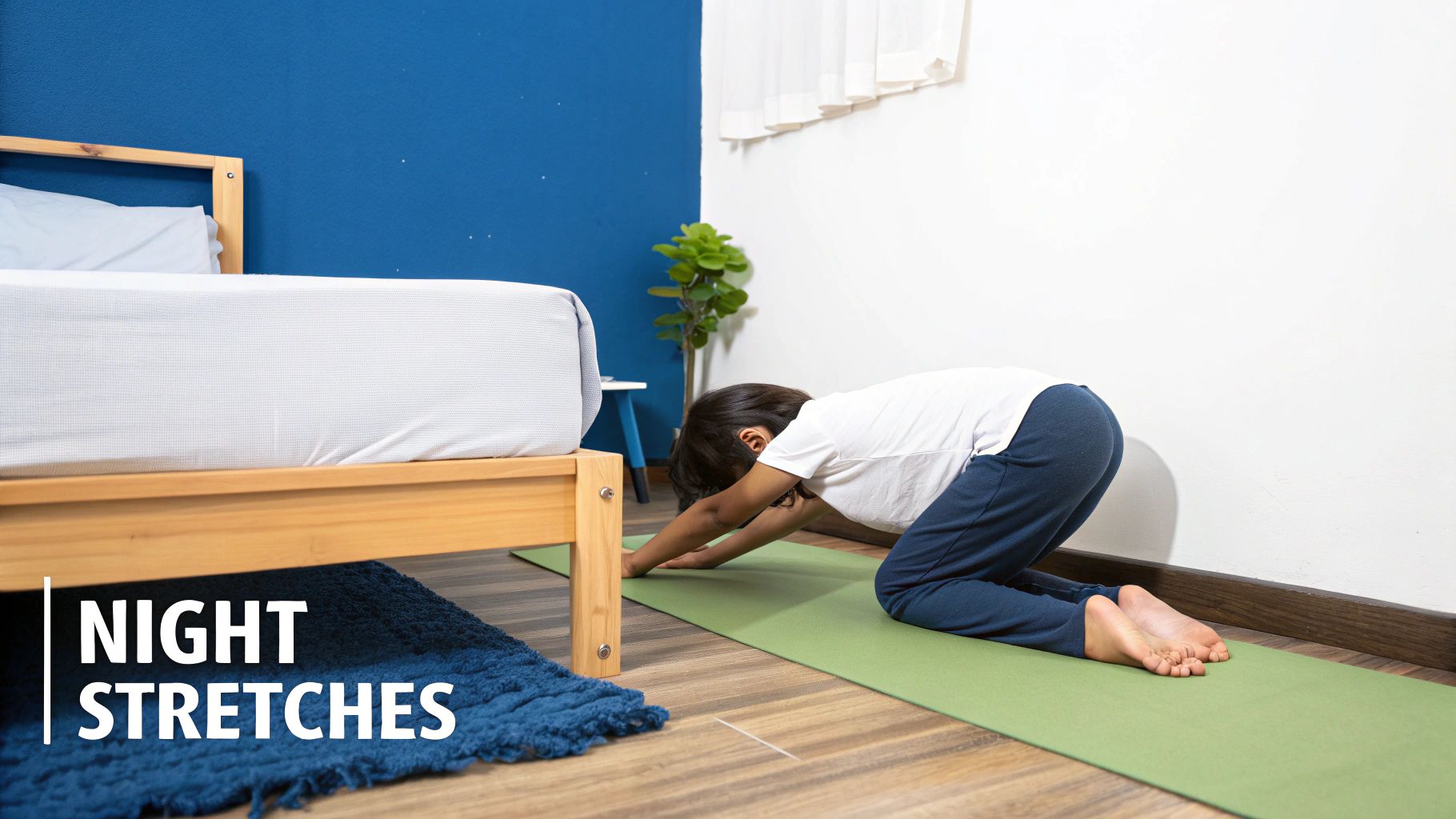If you’re waking up with a stiff neck or an aching back, there's a good chance your sleeping posture is to blame. The secret to fixing this isn't complicated: it’s all about maintaining a neutral spinal alignment. Think of it as keeping your ears, shoulders, and hips in one straight, relaxed line. Making this one change can be the difference between a painful morning and a peaceful one.
Why Your Sleeping Posture Matters
That morning stiffness isn’t just an inevitable part of getting older. More often than not, it’s a direct result of how you’ve spent the last eight hours. When you sleep, your body stays in a relatively static position. If that position puts a strain on your spine, neck, or hips, your muscles never get the chance to fully relax and recover from the day.
The result? You wake up feeling stiff, sore, and like you haven’t slept at all.
Good sleeping posture is about health, not just comfort. When you’re properly aligned, your muscles, ligaments, and spine can truly rest and rejuvenate. The right support system, from your mattress down to your pillows, is absolutely crucial. And achieving this doesn't mean you have to spend a fortune at high-end retailers like Nick Scali or Snooze. At DLB Furniture, our focus is on providing luxury-look bed frames and mattresses at accessible prices, so you can invest in your well-being without breaking the bank.
Understanding Neutral Spinal Alignment
The whole goal here is to support the natural "S" curve of your spine while you sleep. Imagine a straight line running from your head down to your pelvis, with no awkward twists or bends. That's what you're aiming for.
Keeping your spine neutral helps prevent common problems like:
- Neck Strain: Caused by a pillow that's either too thick or too thin, forcing your head out of line.
- Lower Back Stress: Often happens when a mattress sags, letting your hips sink too low and flattening the natural curve in your lower back.
- Hip and Shoulder Pressure: A big one for side sleepers. The right mattress will cushion these major pressure points while still supporting your waist.
If you're dealing with specific discomfort, it's worth learning how to alleviate neck pain while sleeping. Getting these fundamentals right is the first step toward a pain-free morning. We’ll walk you through how to find the perfect setup for your body and budget, with convenient delivery across Greater Sydney right from our Bankstown showroom.
Finding the Best Sleeping Position for Your Body
Figuring out the right way to sleep is one of the biggest wins you can get for your posture, but what’s “best” is incredibly personal. A position that feels like a dream for one person might be the source of aches and pains for another. The real secret is to understand how each position impacts your spine and then tweak it to support your body's unique shape and needs.
Recent Aussie research really drives this point home. A 2022 white paper revealed that 32% of Australians are side sleepers, while 17% sleep on their stomach, and only 9% sleep on their back. What's fascinating is that the report also found nearly a fifth of us cuddle a pillow—a simple habit that can be a game-changer for keeping everything aligned. You can read the full sleep statistics white paper from Sheridan to see more of the findings.
Sleeping on Your Back: The Alignment Champion
Often called the gold standard by physios and sleep experts, lying on your back is fantastic for spinal health. It distributes your body weight evenly across the widest surface of your body, which makes it much easier to keep your head, neck, and spine in a nice, neutral line. This takes a lot of unnecessary pressure off your back.
Of course, it’s not for everyone. Back sleeping can make snoring or sleep apnoea symptoms worse. If you are a back sleeper, make sure your pillow isn't too thick. A pillow that's too high will push your chin toward your chest, putting a real strain on your neck.
Pro Tip: Try tucking a small pillow under your knees. It’s a simple trick, but it does wonders for maintaining the natural curve in your lower back, releasing tension and helping you avoid that all-too-common morning ache.
This whole process—identifying what your body needs, adjusting your setup, and getting aligned—is the foundation of better sleep posture.

This visual guide quickly shows the core steps to improving sleep posture, highlighting how a few small pillow adjustments can lead to proper spinal alignment.
Side Sleeping: A Popular but Tricky Choice
As Australia's most common sleeping style, side sleeping can be brilliant for your back—if you do it right. It helps keep your spine long and straight and is especially good for people with acid reflux or for those who are pregnant. The biggest pitfall, however, is letting your top leg slide forward, which twists your lower back and hips out of whack.
That twisting motion is one of the most common culprits behind lower back and hip pain. Thankfully, the fix is surprisingly simple.
How to perfect side sleeping:
- Wedge a firm pillow between your knees. This is the key to keeping your hips, pelvis, and spine in a straight line.
- Check your head pillow's height. It needs to be just thick enough to fill the gap between your ear and the mattress, which keeps your neck straight.
- Hug a pillow. This little move stops you from rolling too far forward and gives your top shoulder some much-needed support.
Stomach Sleeping: The Position to Avoid
It might feel cosy to some, but sleeping on your stomach is widely seen as the most stressful position for your spine. It flattens the natural curve in your lower back and forces you to keep your head cranked to one side for hours. The result? A recipe for neck and back strain.
If you’re a dedicated stomach sleeper, the best thing you can do for your long-term postural health is to transition to a different position. I know, breaking a lifelong habit isn't easy and takes time.
Making the transition easier:
- Start with strategic pillow placement. Use a body pillow to physically block yourself from rolling all the way onto your stomach.
- Try the semi-stomach position. Lie on your side but tilt slightly toward your stomach, using pillows to prop up your front and another one between your knees.
- Go thin or go without. If you absolutely must sleep on your stomach, use a very thin pillow or no pillow at all for your head. This minimises how much your neck has to twist.
Ultimately, finding your ideal sleeping position is about listening to your body and being willing to experiment. A supportive environment, from a quality mattress to the perfect modern bed frame, lays the groundwork for these habits to stick. If you're in the Greater Sydney area, you can explore our affordable, luxury-style options at our Bankstown showroom to build your perfect sleep setup.
Why Your Mattress Is the Foundation of Good Posture
While we talk a lot about sleeping positions and where to put your pillows, let’s be honest: your mattress is the undisputed foundation of good sleep posture. It's the platform that has to support your entire body for, hopefully, eight hours a night. If that foundation is sagging or unsupportive, no amount of creative pillow-stuffing is going to fix the problem.
Simply put, your mattress has one primary job: to keep your spine in a straight, neutral line all the way from your neck down to your hips. When it fails at this, you feel it.
A mattress that’s too soft is a classic culprit. It lets your heavier parts—like your hips and shoulders—sink in way too far, creating a banana-like curve in your spine. Think of sleeping in a hammock. On the flip side, a mattress that’s rock-hard creates its own problems, generating painful pressure points and not allowing your spine to rest in its natural S-curve.
Finding the Sweet Spot Between Firmness and Comfort
The perfect mattress walks a fine line. It needs to be firm enough to hold you up but have enough give to contour to your body’s curves and cushion those pressure points. For most people, a medium-firm mattress hits that sweet spot, offering the best of both worlds.
Of course, "medium-firm" can feel completely different depending on what the mattress is made of. Getting familiar with the materials is the key to finding what truly works for you.
- Memory Foam: Famous for its incredible pressure relief, memory foam moulds to your unique shape. It’s an absolute game-changer for side sleepers who need that extra cushioning for their shoulders and hips.
- Latex: If you prefer a bit more bounce, latex is a fantastic option. It’s more responsive and breathable than memory foam, giving you a feeling of being lifted rather than being hugged.
- Hybrid: Can’t decide? Hybrid mattresses combine a supportive innerspring coil base with top comfort layers of foam or latex. This construction gives you robust support, pressure relief, and great airflow all in one.
Luxury Feel Without the Luxury Price Tag
There's a common belief in Sydney that a top-quality, supportive mattress has to come with a hefty price tag from a big-name retailer like Nick Scali, Koala Living, or Amart. We’re here to challenge that. You can absolutely find affordable bed frames and mattresses that deliver the same durability, style, and—most importantly—the postural support you need.
To dive deeper, we've put together a detailed guide on finding the best mattress for back pain.
Your mattress isn't just a piece of furniture; it's an investment in your health. A mattress that properly supports your spine can reduce pain, improve sleep quality, and help you wake up feeling genuinely refreshed and restored.
The goal is to find a sleep surface that works with your body, not against it. If you'd like to explore how mattress choice impacts morning aches further, you can check out this helpful guide on finding the best mattress for back pain.
When Is It Time for a New Mattress?
Even the best mattress has a lifespan. Over the years, the materials start to break down, the support fades, and the very thing that used to give you a great night's sleep can become the source of your pain.
Keep an eye out for these tell-tale signs that it's time for an upgrade:
- You wake up with stiffness or back pain that seems to get better as you move around.
- You can see obvious sags, lumps, or a permanent body-shaped indentation in your mattress.
- The mattress is more than 7-10 years old.
- You notice you sleep much better in other beds, like at a hotel or a friend's house.
Investing in a new mattress is often the single most effective way to improve your sleep posture. If you're searching for luxury furniture in Sydney, we invite you to our Bankstown showroom. Come and test out the different mattress types and firmness levels to feel the difference for yourself. With delivery available across Greater Sydney, Melbourne, Canberra, and Brisbane, finding the perfect foundation for a pain-free sleep has never been easier.
Using Pillows to Perfect Your Spinal Alignment
You can have the best mattress in the world, but if your pillow is wrong, your neck is going to let you know about it. A good mattress supports your body, but the pillow is the final, critical piece of the puzzle that ensures a straight, supported line from the top of your head right down to your tailbone.

It’s a common mistake I see people make. They spend a fortune on a mattress but grab any old pillow, completely undoing all the good work. Think of your spine as one connected unit; if one part is out of whack, it creates a chain reaction of strain. The main job of your pillow is simply to fill the gap between your head and the mattress, keeping your neck perfectly aligned with the rest of your spine.
This isn’t about buying the most expensive pillow you can find. It’s about finding the right pillow for your body and sleeping style—a small but powerful investment in your health.
Matching Pillow Loft to Your Sleep Position
The most important factor here is the pillow’s loft, which is just a fancy word for its height. The ideal loft depends entirely on how you sleep.
-
For Back Sleepers: You need a thinner, lower-loft pillow. It should be just thick enough to cradle the natural curve of your neck without forcing your chin down toward your chest. Too much height is a one-way ticket to neck strain.
-
For Side Sleepers: This is where a thicker, higher-loft pillow is a must. Your pillow has to completely fill the space between your ear and your outer shoulder to keep everything straight. If it's too thin, your head will sag; too thick, and it’ll be pushed up at an awkward angle.
Your pillow isn't just a soft spot for your head. It's an alignment tool for your entire upper spine. Getting the loft right maintains that crucial neutral position, preventing the muscle strain that leads to a stiff, sore neck in the morning.
Getting these details right can make a huge difference. For a deeper dive, check out our guide on how to choose the right pillow for better sleep in Sydney.
Beyond the Head Pillow: Strategic Support
Sometimes, one pillow just isn't enough. Using extra pillows to support other parts of your body can provide targeted relief and stop you from twisting into pretzel-like shapes during the night. This is where you can get a bit creative to solve your specific aches and pains.
For instance, if you're a side sleeper, try putting a firm pillow between your knees. It's a simple trick, but it's incredibly effective. It stops your top leg from sliding forward and twisting your pelvis, which is a very common cause of lower back and hip pain.
Back sleepers can also get a lot of relief by tucking a small pillow or even a rolled-up towel under their knees. This helps maintain the natural curve of your lower back, taking the pressure off those muscles and letting them truly relax.
A Cohesive Sleep System for Lasting Comfort
Achieving great sleep posture is all about creating a system where every piece works together. It all starts with a solid foundation—one of our stylish and supportive bed frames, which we can deliver right across Greater Sydney. From there, you layer on the right mattress for your body and top it off with the perfect pillow setup.
This synergy is what creates a truly restorative sleep environment. Just like you'd pair a sintered stone dining table with the right velvet chairs for a cohesive look, your bed requires a thoughtful combination of elements. Our modern wardrobes in materials like premium MDF and Tasmanian Oak can complete your bedroom suite. When your frame, mattress, and pillows all work in harmony, you're not just buying furniture; you’re investing in waking up without pain.
If you’re not sure where to begin, come and see us at our Bankstown showroom. You can explore our range of affordable bed frames and sleep accessories, and our team can help you put together the perfect, posture-friendly sleep system that delivers on style without the high-end price tag.
Simple Stretches and Habits for Better Sleep Posture

While your mattress and pillows are the foundation, your daily habits and pre-sleep routine play a surprisingly powerful role in your sleep posture. Think about it: the tension you carry in your muscles from a long day at a desk or on your feet doesn't just vanish when you lie down.
Addressing that built-up tension before bed is a crucial step. It allows your body to settle into a truly neutral, relaxed position for the night. By working a few simple stretches and mindful habits into your evening, you can release tight muscles, calm your nervous system, and prepare your spine for restorative rest. This isn’t about a strenuous workout; it’s about gentle movements that signal to your body it’s time to unwind.
A Gentle Pre-Sleep Stretching Routine
Think of these stretches as a way to decompress your spine and undo the day's stresses. A quick, five-minute routine on the floor next to your bed can make a world of difference, especially for your lower back and hips.
Here are a few gentle movements to get you started:
-
Cat-Cow Stretch: Begin on your hands and knees. As you breathe in, let your belly drop and look up, arching your back (Cow pose). As you breathe out, round your spine up toward the ceiling and tuck your chin to your chest (Cat pose). Flow between these two positions 5-10 times to gently mobilise your entire spine.
-
Child's Pose: From your hands and knees, sit back on your heels and fold your torso forward. Rest your forehead on the floor and stretch your arms out in front of you. This pose is fantastic for releasing the lower back and hips—two areas that often hold a lot of tension.
-
Gentle Spinal Twist: Lie on your back and hug your knees into your chest. Extend your arms out to the sides in a 'T' shape. Gently let both knees fall to one side, doing your best to keep both shoulders on the floor. Hold for about 30 seconds, then switch to the other side. This is great for releasing tightness along the sides of your back.
These movements are designed to be calming, not challenging. They help improve blood flow and encourage your muscles to relax fully before you even get into bed.
Building Healthier Bedtime Habits
Your actions in the hour or so before sleep can either help or hinder your posture. Creating a relaxing wind-down period is just as important as the stretches themselves. One of the biggest culprits? Screen time. Looking down at a phone or laptop for extended periods puts a real strain on your neck muscles—a problem you don't want to carry with you into bed. A stylish TV unit from our Bankstown showroom can help create a dedicated, ergonomic viewing space away from your bedroom.
A consistent pre-sleep routine does more than just relax you—it actively prepares your body for proper alignment. By releasing muscle tension and avoiding postures that cause strain, you give your spine the best possible chance to rest and recover overnight.
For younger Australians, getting into these healthy habits early is especially important. Research has shown that while 73.6% of adolescents in Australia start with a decent sleeping position, this percentage often declines over time, particularly for girls. You can learn more about these findings on sleep posture trends and see why a little bit of early awareness goes a long way.
A holistic approach to sleep hygiene is always the best way forward. We've put together a list of other small but powerful adjustments you can make in our article on the top 10 ways to improve your sleep in 2024.
Ultimately, fixing your sleep posture is about creating a supportive ecosystem for your body. It all starts with a quality mattress and a stylish, durable bed frame, continues with the right pillows, and is perfected by these mindful daily habits.
Answering Your Sleep Posture Questions
Even with the best intentions, changing lifelong sleep habits can bring up a few questions. Let's tackle some of the most common ones I hear from people trying to get their sleep posture sorted.
How Long Does It Take to Fix Sleeping Posture?
This is probably the number one question people ask, and the honest answer is: it varies. There's no set timeline, but most people start to feel a real difference within a few weeks to a couple of months.
Remember, you're trying to unlearn a habit your body has likely held for years, so patience is key. Think of it like training a muscle. The real secret is consistency. To speed things up, use pillows to your advantage. If you're trying to stop sleeping on your stomach, for instance, a full-body pillow can be a game-changer, acting as a gentle barrier to keep you on your side.
Is It Better for Your Back to Sleep Without a Pillow?
For almost everyone, sleeping without a pillow is a bad idea. When you lie down without any head support, your head tends to tilt backward, putting a huge amount of strain on your neck and upper spine. It throws that neutral alignment we’ve been talking about completely out the window.
The only real exception is for die-hard stomach sleepers. In that case, using a very thin pillow or no pillow at all can lessen that severe neck twist. But for back and side sleepers? A good pillow isn't just a comfort item—it's essential for proper support.
What Is the Healthiest Sleeping Position?
If we had to award a gold medal, it would go to back sleeping. It's the champion of spinal health because it distributes your weight evenly across the mattress, making it far easier to keep your head, neck, and spine in a straight, happy line. Pro tip: placing a small pillow under your knees takes the pressure off your lower back and supports its natural curve.
Coming in at a very close second is side sleeping. The key here is to slide a firm pillow between your knees to keep your hips aligned and prevent your top leg from pulling your spine out of position. Stomach sleeping, unfortunately, comes in last place every time due to the major strain it puts on your neck and back.
Getting our sleep posture right is a massive public health concern in Australia. In fact, research shows that sleep-related problems, often made worse by poor posture, can impact up to 50% of Australians. These issues often hit harder in underserved communities, which just shows how important good sleep education is for everyone. You can discover more insights on Australian sleep health equity from recent studies.
Can My Old Mattress Cause Poor Posture?
Without a doubt. An old, sagging mattress is one of the biggest offenders when it comes to morning aches and poor sleep posture. After 7-10 years, most mattresses lose their ability to provide even support, and that's when problems start.
A worn-out mattress lets your heavier parts, like your hips and shoulders, sink in too far. This forces your spine into an unnatural curve that you hold all night long. If you're waking up stiff and sore, or you can see a permanent body-shaped ditch in your mattress, that's a massive red flag. Your mattress has done its job, and it’s time for an upgrade. Think of a quality mattress not as a luxury, but as a long-term investment in your well-being.
At DLB Furniture, we believe everyone deserves a pain-free morning. Explore our collection of supportive mattresses and stylish bed frames that offer luxury design without the high-end price tag. Visit our Bankstown showroom or shop online today to explore our full range of coffee tables, wardrobes, and bedroom furniture.










